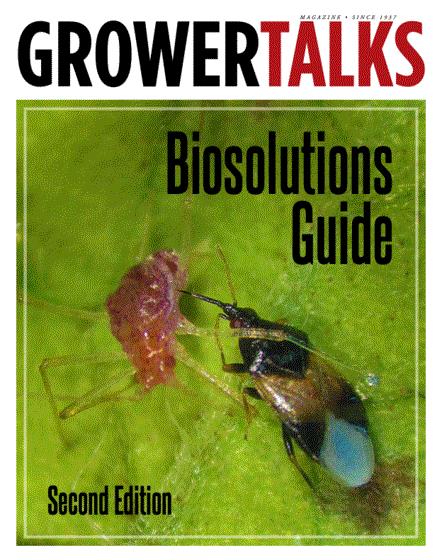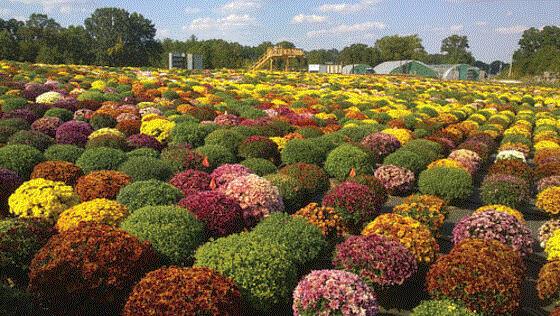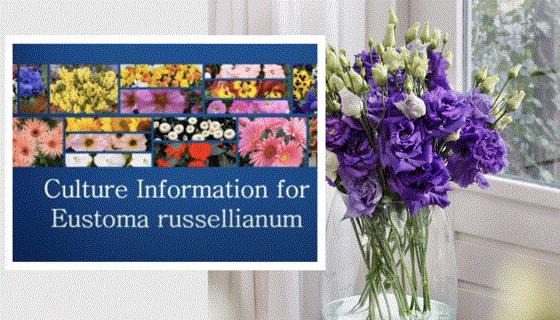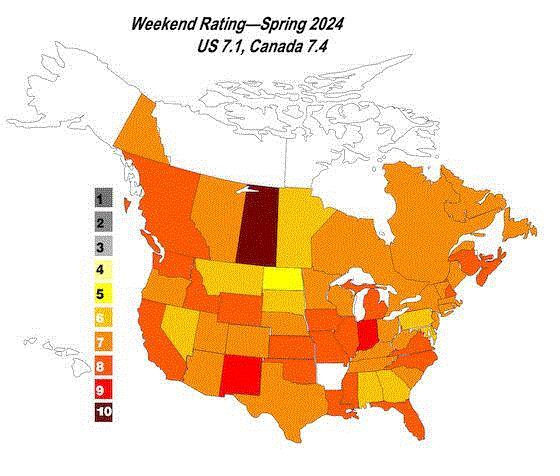NEW PODCAST EPISODES! Biosolutions with Jeremy Webber
The latest Tech On Demand podcast, brought to you by GrowerTalks is actually a two-part episode focused on biocontrols, bios, biologicals, beneficials or however you care to refer to biosolutions for the horticulture industry. It’s the first in a series of podcasts spinning off from the 2024 GrowerTalks Biosolutions Guide special supplement (more on that later …).
My guest for episodes 134 and 135 is Jeremy Webber, cannabis and ornamentals crop team manager at Koppert, a Dutch company that’s been innovating in the biosolutions space for more than 50 years. Koppert is a global market leader specializing in biological crop protection, and Jeremy has been with the company for almost 15 years and is well-versed in all things biosolutions and an excellent speaker who doesn’t hold back, so I assure you these are dynamic and informational episodes!

Over the course of about an hour total we discuss why growers are seeking biocontrol strategies more and more; the best gateway pests and bios to start with; how to approach the conventional vs bio cost equation; SOPs for a few different common biocontrol scenarios; what every grower should do on Fridays before leaving the greenhouse; why nematodes always work on fungus gnats; eyeless, dumb predatory mites and much, much more.
Jeremy and I start episode one discussing the history of Koppert, as well as the company’s vision for 100% sustainable agriculture, before moving on to why biosolutions are on just about every greenhouse professional’s mind and why more are considering bios every year. Then I jump into some rapid-fire questions based on discussions with growers and their most-asked questions—like when to use bios versus conventional pesticides and how costs line up between the two. Throughout the first part, Jeremy considers why he (a former grower) feels biological approaches are critical for our industry’s future, the importance of trust when partnering with a biosolutions supplier, some examples of success moving the industry forward and why bios are a sustainable strategy for any greenhouse operation.
In the second part, Jeremy and I dive into some more tactical topics like “gateway” pests to start approaching with biological controls, some favorite predators, unexpected lessons learned from the cannabis side of the industry and why “trials” is possibly not the best word to use when implementing biosolutions on a small scale. Since Jeremy has plenty of greenhouse production experience, I asked him for some absolute no-brainer ways that biocontrol strategies can be implemented into any greenhouse immediately—with just-about-guaranteed results.
Before closing, we chat a bit about what biosolutions in horticulture will look like in the future and why the market is in the right place at the right time. Jeremy also shares a couple quick tips for application and release best practices for biocontrols from his article in the 2024 GrowerTalks Biosolutions Guide.
Be sure to start with EPISODE 134 and then continue with EPISODE 135 because they fit together perfectly.
You can find the Tech On Demand Podcast, brought to you by GrowerTalks on Spotify, Apple Podcasts and just about any other app. You’ll want to subscribe, as well, so you never miss an episode and take some time to jump back in the archives for more than 130 episodes covering a wide range of topics for greenhouse professionals.
TECH ON DEMAND ON SPOTIFY
TECH ON DEMAND ON APPLE PODCASTS

2024 Biosolutions Guide
We launched the first edition GrowerTalks Biosolutions Guide last year with the goal of shining a light on one of the most dynamic discussions within the horticulture industry. Educational sessions related to the topic are always packed with attendees, new product displays are filled with bio-based items and much of our industry’s cutting-edge research follows this path, as well. The conversation is not new, but it is top-of-mind for many greenhouse professionals. GrowerTalks has been helping vet and share information and strategies related to biosolutions for many years and it has been exciting to see what was once a niche approach to greenhouse production become mainstream.
And that’s where we stand now, with some of the largest greenhouses in North America adopting and fine-tuning bio-based production protocols, and growers at all levels of the industry trusting biosolutions for pest and disease management, plant health optimization, labor savings and improved worker safety. Biosolutions are critical ingredients in most growers’ recipes for crop quality. Our industry is evolving quickly and new research, information and products in the biosolution space is coming available at equal speed.

The SECOND EDITION 2024 GROWERTALKS BIOSOLUTIONS GUIDE is filled with the latest data, trial results and innovative approaches proving effective in commercial greenhouse production. The experts who’ve submitted content are leaders in research and applied technology and are constantly challenging our industry to consider new ways to implement bio-based strategies with the end goal of sending amazing quality to market.
With an attempt to merge data and application, we’ve asked some industry leaders in the biosolutions space to discuss what’s new and—more importantly—what growers need to know to achieve success with products and approaches rising to the forefront. Michael Brownbridge (BioWorks Inc.) dives deep into microbial biofungicides; Ann Chase reports trial results from biofungicides derived from plant extracts and biopesticides based on Bacillus strains; and Suzanne Wainwright-Evans shares the latest on banker plants for pest management and answers some of the most frequent questions she gets from commercial growers. In addition, we reached out to experts from Mycorrhizal Applications and Koppert to explain ways to incorporate mycorrhizae into production plans and effectively apply biocontrol agents.
In the guide’s 30+ pages, you can expect to find tons of hard data (check out the updated biofungicide and bioinsecticide charts), fresh approaches and proven strategies. Read these articles with an open mind and I promise you’ll (digitally) close the back cover with dozens of new ideas and plans to trial new products.

Josh’s Guest Tip of the Week: A FED Wet Mum is Better than a HUNGRY Wet Mum
This week, Dr. Josh Henry (another awesome Ball Tech On Demand expert) is taking over this newsletter spot from Nick Flax to share some important information on summer mum production that’s been coming up lately in conversations with growers and the Ball Mums team.
PROBLEM: With the recent passage of Hurricane Beryl and the accompanying heavy rains, it's essential to focus on proper irrigation and fertilization practices for outdoor mums. When it rains, the relatively pure, low electrical conductivity (EC) rainwater displaces the nutrient charge in the substrate from prior fertilization. This leaves the substrate fully saturated with virtually no mineral nutrition for the plant to take up, and it can take days for the substrate to dry down enough for the next irrigation. However, leaving mums wet and hungry for several days is a dangerous combination, so consider this tactic—which may go against your better judgement as a grower.

JOSH’S TIP: After a heavy rain event, immediately fertilize your mums to displace the low EC rainwater with the mineral nutrition they need to keep growing. This may seem counterintuitive, but if the substrate is already fully saturated, you’re not adding water, but rather displacing the water with nutrients.
Another benefit of fertilizing immediately after rainfall is preventing the pH from creeping up. High substrate pH values often follow heavy rain, but adding a fertilizer, especially from an acidic formulation like 20-10-20, will help maintain optimal pH levels and prevent common symptoms of upper leaf chlorosis that accompany high substrate pH caused by iron (Fe) deficiency.
Some of you opt to use controlled release fertilizers (CRFs), either incorporated into the substrate or top-dressed after transplanting. These fertilizers provide a constant stream of nutrients into the substrate even after heavy rain, which helps maintain EC. However, CRFs alone likely cannot replenish nutrients as quickly as necessary following a heavy rain event, so growers using CRFs should still consider applying water-soluble fertilizer after rain.
Here are a few pro tips for success:
-
Fertilize after rain. Persistent rain on outdoor mums flushes available nutrients from the substrate, so it is essential to replace those nutrients quickly to maintain growth.
-
A note on CRFs. For CRF users, replenishing nutrients with water-soluble fertilizer is critical to prevent nutrient stress, which can lead to crown budding.
-
For outdoor production. Remember that a wet, well-fed mum is better than a wet, hungry mum. After any heavy rain event, be sure to pump your crops back up with feed, but also monitor root health and utilize a good fungicide rotation to prevent root rot.
-
For greenhouse production. Indoor growing means there will be no rain flushing nutrients out of your pots; however, prolonged low light and high humidity will reduce nutrient uptake, so monitor substrate EC and reduce your feed slightly to avoid root burn.

Growing Lisianthus: Everything You Need to Know (in one video!)
In a COMPREHENSIVE VIDEO covering a key cut flower, Ball Seed’s cut flower business manager Joan Mazat and Sakata Seed America’s product technical manager Bob Croft discuss lisianthus and share tips and tricks for selecting and producing top-quality crops.

You’ll quickly realize that Bob has tremendous knowledge about and experience with lisianthus, as he walks greenhouse growers and flower farmers through the ins and outs of the crop—from site preparation and proper classification/grouping to managing all factors of plant growth (light, water, nutrition, temperature and gas exchange) and controlling pests and diseases. Bob wraps up with harvesting protocols, post-harvest strategies and storage tips before he and Joan share some of their favorite series and why lisianthus is a cut flower favorite.
For even more cut flower resources and videos from Ball Seed, click HERE. And be sure to explore SAKATA’S TECHNICAL INFO ON CUTS, as well!
Acres Online Spring Recap: Pretty Average
Last week in his Acres Online e-newsletter, Chris Beytes crunched the numbers and tallied up his weekly scores for Spring 2024. After 13 weekends of gathering scores, including four holidays (Easter, Mother’s Day, Memorial Day and Victoria Day in Canada), the results reflect what you’ve been telling him the last couple of weeks: It was an average season at best.
The final tally? 7.1 in the U.S. and 7.4 in Canada. That’s out of 10—based on 1,317 scores over 13 weeks in every state besides Hawaii, Alaska and Arkansas (and just about every province).

According to Chris:
This year’s results are well down from last year’s 7.5/7.6, but pretty close to the 12-year averages of 7.3/7.2. Nothing will likely top the pandemic years of 2020 (8.1/8.2) and 2021 (8.2/8.1). In fact, if we toss those years out, the average drops to 7.1/7.2.
More from Bossman Beytes:
I don't think any spot had a great season throughout. Every place had good times and bad stretches. The Northwest and South started strong but dragged in May and June. The Midwest also got off to a strong start, and had a great May, but weakened at the end. New England took a while to build up momentum. And the East really never got going until the very end.
What state would I have wanted to be doing business in this year? (I’ll pick one that had multiple scores each week to make it fair.) Illinois managed 8.0 for the season, with a super-strong 8.8 for April, 8.2 for May and an unfortunate 6.9 for June when the heat dome hit.
California did well at 8.2 for the season: 7.9 in April; 9.0 in May and 7.5 in June.
Kansas (8.0) was another state that did great for two of the three months: 8.8 in April, 8.0 in May and 7.1 in June.
That seemed to be the story most places: some of spring was excellent … just not enough of it.
Where would I have NOT wanted to be plying the plant trade? A skim down the list shows North Dakota at 5.0, Maryland at 5.9 and Delaware at 6.0. Really, it was one of those seasons where I'm glad to be writing about it, not actually doing it—you guys and gals work HARD!
(Meanwhile up in Canada …) BC and Quebec really took off in April, with Alberta also performing well. BC did okay in May and June, but not what they could have done. Ontario had a fair May, but also never really got going. And Quebec collapsed in the peak months.
Weather, people! I tell you, that’s what matters most. That and having good product and making the effort to draw in customers. I can’t tell you how many times I’d see a 5 and a 9 from the same state for the same weekend, and the 9 was based on an event or sale or some other enticement that got the customers in the door.
1,300 data points is excellent, but Chris can always use more! If you’re not subscribed to ACRES ONLINE, go ahead and click the link to get squared away. We’d love to see you participating in next spring's survey.

Finish Line …
Wrapping up this week’s newsletter, it seems like I haven’t written as much on poinsettias as past years. Maybe that’s because the Tech On Demand week-by-week, step-by-step videos continue to get plenty of views and I know most are aware they’re out there, but I should continue to remind you about these great resources.
To stay ahead of poinsettia season and help get you and your team prepared for success, be sure to bookmark our series of poinsettia production videos. Thanks to guest experts from Selecta One, the poinsettia production Tech On Demand playlist includes more than 35 short videos.
For example, transplanting poinsettias is obviously critical and can be tricky. In POINSETTIAS (PART EIGHT) TRANSPLANT & ENVIRONMENT, the experts take you through what you and your team need to know to effectively transplant your rooted cuttings when they’re ready and the greenhouse environment that will ensure a good start. They cover proper media moisture and irrigation before moving to temperature and humidity, while offering tips for what to expect and warnings about what to avoid.
Okay, I feel better now that poinsettias were covered this week. Now I can go start packing for Cultivate. If you’re heading to Columbus this weekend, be sure to stop by the Ball Publishing booth (2403) and if you see me at any of the educational sessions (I have 10 on my list to attend) or on the show floor, be sure to say hi!




Please feel free to send your comments, constructive criticism and topic ideas to me at bcalkins@ballhort.com.

Bill Calkins
Editor - Tech On Demand
This email was received by you and 25,826 other fine subscribers!
If you're interested in advertising in Tech On Demand, contact Kim Brown ASAP and she'll hook you up.